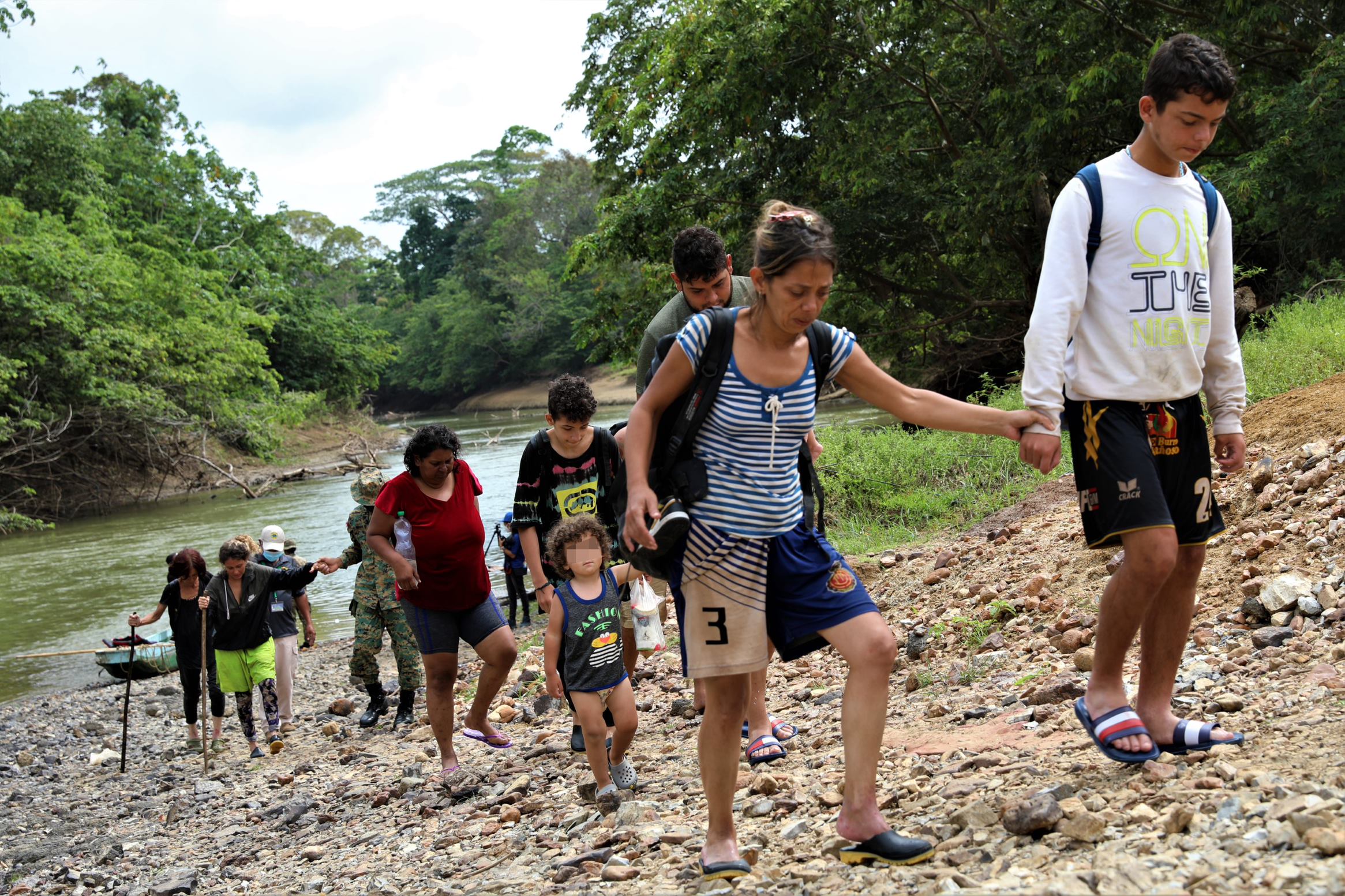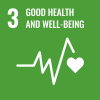San Vicente, 4 April 2022 – With a bag full of hopes and dreams, Iriana Ureña, a 32-year-old Venezuelan mother of two, arrived at a Migrant Reception Station (ERM) in San Vicente, at the edge of the Darien Gap. The look in her eyes showing the pain of a mother who would do anything to protect her children.
Iriana and her husband Eduardo decided to take the journey north from Venezuela through the jungle with their two children in search of better opportunities. The decision to leave their country, home, family, friends, and a life's work to start all over again was a difficult but necessary one for them and many other migrants. They were hungry, dehydrated, and exhausted upon arrival at the station.

Iriana Ureña, her husband Eduardo and their children Fradyely (9) and Mia (1) talking to other migrants. Photo: IOM/Gema Cortes
“The road was not easy, I felt that our lives were in danger. It was challenging because we saw very ugly things along the road, things that I would never think I would see in my life,” said Iriana.
According to statistics from Panama Migration Services, nearly 134,000 people, 80 per cent of whom were Haitians, risked their lives through the dense jungle in 2021. This is a record number of people crossing the 10,000 square mile rectangle of trackless jungle, rugged mountains, turbulent rivers, swamp, and deadly snakes that spans both sides of the border between Colombia and Panama. Today, the journey through the gap is made more perilous by criminal groups and smugglers who control the region, often extorting and sometimes sexually assaulting migrants.
Aerial shot of Darien Gap. Photo: IOM/Gema Cortés
Migrants cross the Chucunaque river in the Darien Gap searching for a better life. Photo: IOM/Gema Cortés
Migrants cross the Chucunaque river in the Darien Gap searching for a better life. Photo: IOM/Gema Cortés
However, the dynamics are changing as the jungle no longer sounds Creole. The Haitians, who used to cross this dangerous trail in masses are no longer the majority. They are still trying to get from Colombia to the United States, but Spanish and the resounding "panas" of the Venezuelan migrants now prevail on the trail.
The numbers of Venezuelans crossing the Darien Gap in the first two months of 2022 (some 2,497) almost reached the entire total for 2021 (2,819), becoming the main group crossing the heart of the rainforest. But this list also includes Cubans, Haitians, Senegalese, and Uzbek nationals, among others.

Migrants from all over the world arrive extenuated in Lajas Blancas after braving the dangerous Darien Gap. Photo: IOM/Gema Cortés
Scaling up aid
Emerging from the gap, most migrants pass through the Bajo Chiquito or Canaan Membrillo communities before making their way on foot or by community boats along the muddy waters of the Chucunaque River. The probability of suffering physical and psychological violence is very high throughout the whole journey.
The International Organization for Migration (IOM) works with the government in coordination with other agencies to provide assistance to people in transit and host communities.

Migrants arrive, extenuated and thirsty, at the Migration Reception Center after crossing the Darien Gap. Photo: IOM/Gema Cortés
"Responding to the needs of migrants transiting irregularly through Panama poses significant challenges mainly related to funding," says Santiago Paz, Chief of IOM Panama and Head of the Panama Global Administrative Center (PAC). "In this sense, there is an urgent need to redouble coordination between governments and international cooperation to respond to the humanitarian needs of the population in transit."
In recent years, the Panamanian government has put in place infrastructure to temporarily house the population in transit and attend to the humanitarian needs of this growing migrant population. With technical support from the IOM and other international organizations, Panama has installed three ERMs, where migrants find lodging and food, and where potential cases of COVID-19 are monitored.

Migrants queueing for food after crossing the Darien Gap. Photo: IOM/Gema Cortes
Among the newly arrived migrants is Johainy, a Venezuelan mother, and her one-year-old baby.
“We faced a lot of difficulties, we were robbed, and saw dead people along the way. Though we prepared ourselves as much as we could watching many videos about the route, nothing could totally prepare us for what we experienced in the forest.”

Kettenise Saintilus, from Haiti, and child after crossing the Darien Gap. Photo: IOM/Gema Cortes
Mariel Rodriguez, Cultural Promoter for IOM Panama based in Darien, works with the migrants. She walks around the centre to provide migrants orientation and information. “The migrants we assist in the ERM are in a situation of extreme vulnerability and have very varied needs, from knowing in which country they are arriving, to medical assistance, clothes or basic hygiene products. The IOM team responds to these needs and coordinates with other government agencies and institutions to ensure access to available services.”
With a population of around 7,000 people, Meteti town has swollen in recent years with migrants – mostly Venezuelans, like Iriana, as well as Cubans, South Americans, Africans, South Asians, and others, all aiming for the United States or Canada.
IOM has balanced the needs of both migrants and host communities at the Panama-Colombian border with financial and policy support. This has reduced migrants’ vulnerability and assisted those who welcome them.

Bijou Ziena Kalunga, from the Democratic Republic of the Congo, gave birth to Hamdi while crossing the Darien Gap. Photo: IOM/Gema Cortes
Getting beyond the gap in search of a better life
For thousands of migrants around the globe the perilous, roadless jungle becomes a path of desperate hope to the north in search of a better life. A babel of languages mixes in the vast jungle, from where some never emerge alive, though the death toll is unclear. They come from Haiti, Venezuela, Cuba, but also many countries in Africa and Asia. Many often passed through South American countries after working for months or even years.
Migrants continue to stream through the Darien Gap, many with stories or signs of trauma, like Shahzad from Pakistan (“We found dead bodies and skulls during the walk”) or Esther, who arrived extenuated, with blood-blistered feet, and hand carried by other people.

Tears of joy as a family is reunited after several days apart in the jungle: Venezuelans William, Jorgeis and a six-month-old baby. Photo: IOM/Gema Cortes
Others arrived with stories of hope. “The hike was extremely hard. I went into labour and I had my baby Hamdi in the middle of the forest with the only help of my husband. I had to drink water from the river for days. However, the newcomer gave all the family a renewed sign of hope I did not expect," said Bijou Ziena Kalunga, 33, from the Democratic Republic of the Congo.
Or tears of joy as families are reunited after several days apart in the jungle, like Venezuelan William, Jorgeis and a six-month-old baby. “I was really sad, and I kept praying for my husband to arrive. I can´t say how happy I am to have him back,” Jorgeis said.

Bangladeshi migrant talking to loved ones at home at the Reception Center after crossing the Darien Gap. Photo: IOM/Gema Cortés
In the reception station, migrants crowd around every available electrical socket, charging their phones while they type on WhatsApp to loved ones back home. They talk about their hazardous way through the forest and their plans and hopes for the future.
Serigne Nor Sarr, 33, has modest ambitions. "My hope for the future is to work, start a family and lead a very simple life," he said, standing outside his temporary shelter. The young Senegalese man has already spent more than four years in Brazil where he worked to get enough money for the trip. "We were treated well there," he said, “but I always planned to leave someday for my dream destination in the United States.”

Serigne Nor Sarr, 33, from Senegal, after crossing the Darien Gap. Photo: IOM/Gema Cortes
It's a dream shared by thousands who arrive in Meteti – a place where some of the world’s hardest stories meet some of the world’s kindest hearts. “The risk is worth it, if it means that I can reach the United States and start over a new life with my family,” whispered Iriana with a hopeful look.
*The San Vicente ERM was built by the Government of Panama with support from international cooperation, intergovernmental organizations, civil society, and the private sector. San Vicente provides dignified conditions in which physical separation and other biosecurity measures can be maintained to mitigate the spread of COVID-19.
***
This story was written by Gema Cortes, IOM Media and Communications Unit, Office of the Special Envoy for the Regional Response to the Venezuela Situation.



